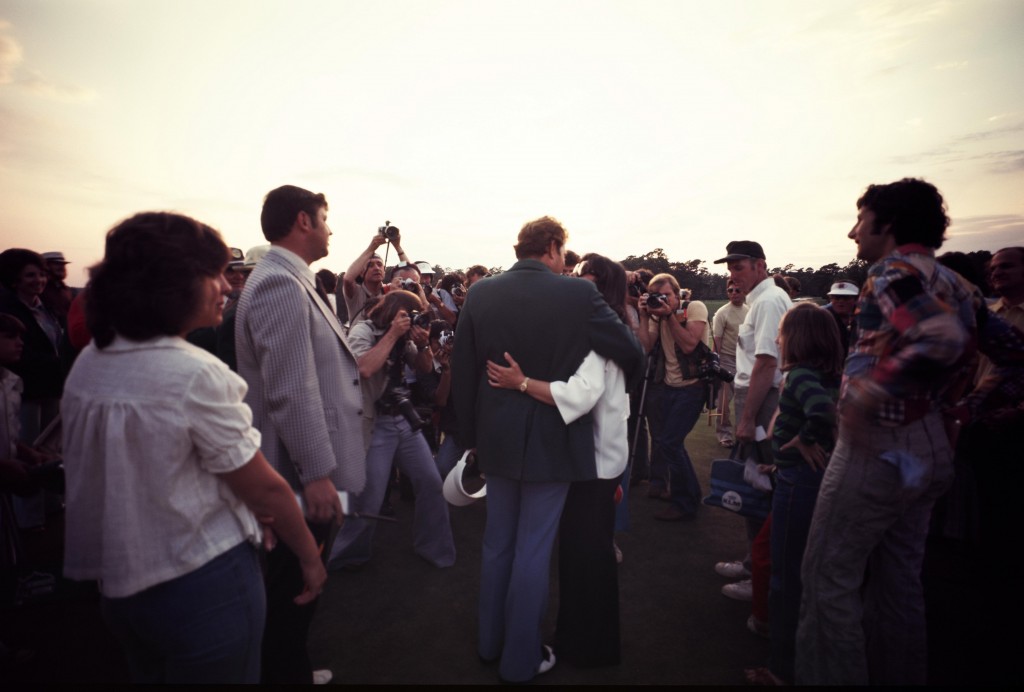By Dave Cordero, World Golf Hall of Fame
It was an unusually warm Sunday afternoon at Sedgefield Country Club in Greensboro, North Carolina. Al Geiberger had just holed his last putt to complete a 16-under-par performance earning him $46,000 and his eighth PGA TOUR win.
Not far from the golf course was an inconspicuous Raymond Floyd, who had already finished his final round at Sedgefield and was making the four-hour pilgrimage to Augusta National for the playing of the 1976 Masters Tournament.
A six-time winner, Floyd had not tasted victory on the PGA TOUR since the previous summer when he won the Kemper Open in his home state of North Carolina. To his own admission, he was striking the ball well, but not putting well enough to stay atop leader boards early that season. Like all players, Floyd knew if he was going to compete at the Masters, putts would need to start falling.
Until then, the 34-year-old Floyd was not the name media members and prognosticators were calling to win the season’s first Major. Besides, there were too many likely candidates playing well headed into the Masters. Take Hubert Green for example, who just two weeks prior, had won three straight PGA TOUR events. Ben Crenshaw had also laid claim to consecutive wins in Pebble Beach and the Hawaiian Open. And always looming nearby was the seemingly invincible Jack Nicklaus, Johnny Miller and Lee Trevino who had a knack for rising to the occasion.
Little did the golf world know that Floyd had not only rediscovered a newfound confidence in his putter after carding a final round 66 in Greensboro, but he was also about to reinvent his golf bag set-up and add a high-lofted, persimmon 5-wood. Unlike today’s game, 5-woods were considered ladies’ clubs and men favored 1-irons and 4-woods.
With Augusta National’s fast, firm and unreceptive Bermuda greens on his mind long before his impending drive down Magnolia Lane, Floyd was in search of a club that would travel 200 yards in the air and land softly on the greens. Floyd, known for his imagination, was looking for an alternative way to attack Augusta’s Par 5s.
Floyd connected with Memphis golf club maker Bert Dargie who scored Floyd six different 5-woods, which he would feverishly test back home at La Gorce Country Club in Miami Beach.
“I remember the first two immediately cracked at the hosel, and two of them did not look and feel right,” said Floyd. “So of the six, I had two gamers. One of those gamers also cracked so I decided to save the last one for Augusta. It performed beautifully and I knew it was going to be my secret weapon.”
With the rediscovered magic of his putter, his new 5-wood and a strong support system anchored by his wife Maria, the stars were seemingly aligning and Floyd was at the precipice of golf history.
“Maria and the kids had already left for Augusta,” recalled Floyd. “I was making the drive by myself and remember grinning ear-to-ear because my confidence was so high. The tournament couldn’t start soon enough.”
Floyd’s confidence translated into an opening round 65, two shots better than Nicklaus. That lead over Nicklaus and the rest of the field grew to five after a solid 66 the following day.
The long days of practice with his 5-wood were paying off. Floyd was launching the ball higher in the air than the 2-iron in which he had replaced. Frustration mounted among the rest of the playing field as shots imparted with long irons and strong lofted fairways continued to run off the greens. Floyd’s shots soared majestically into the spring sky and landed safely onto the green, setting up scoring opportunities which were rarely not converted.
In the first three rounds, Floyd had 11 birdies and an eagle on the Par 5s. Remarkably, Floyd had hit more Par 5 greens in two, than number of bogeys on his card.
As a result, Floyd’s 54-hole total of 201 (-15) was a new Masters record.
Aside from a 67 in round three by Hale Irwin, Floyd flourished again firing a two-under-par 70, extending his lead to eight over Nicklaus.
Like most wire-to-wire winners, Floyd sucked all the drama out of Sunday when he posted a final round 70 for a 271 tournament total – eight strokes clear of Crenshaw, the runner-up finisher.
“When Raymond Floyd got his nose out in front, there was no catching him,” said Crenshaw. “He just kept pouring on the cooking oil. We saw him do this so many times in his career. He was a great front runner and he simply outclassed everyone that week. That may have been one of the most convincing victories the golf world had seen.”
After donning his first Green Jacket, Floyd went back to work and turned in a solid 1976 season. He finished 13th at the U.S. Open and placed inside the Top-5 at both the Open Championship and PGA Championship. He also won for the eighth time at the World Open Golf Championship.
Beyond a magical 5-wood or a hot putter, there was more substance behind Floyd’s success. Three years earlier, Floyd had married his wife Maria, who he credits with changing his life around. Floyd likes to say that he had two careers in his life and the better career was the one that lasted 40 years with Maria at his side. She was a non-golfer who quickly acclimated herself and helped keep Raymond grounded.
Floyd grabbed 17 of his 22 wins after meeting Maria, proving that “behind every good man is a good woman.”
Maria passed away in 2011. Her ashes were ceremoniously spread at Augusta National underneath the umbrellas near the first tee – the same spot where the Floyd family would convene every spring.
Before entering into the World Golf Hall of Fame in 1989, Floyd would win one U.S. Open and another PGA Championship.
But nothing is sweeter or more emotional than his lone Masters win 40 years ago. Truly a performance for the ages.


